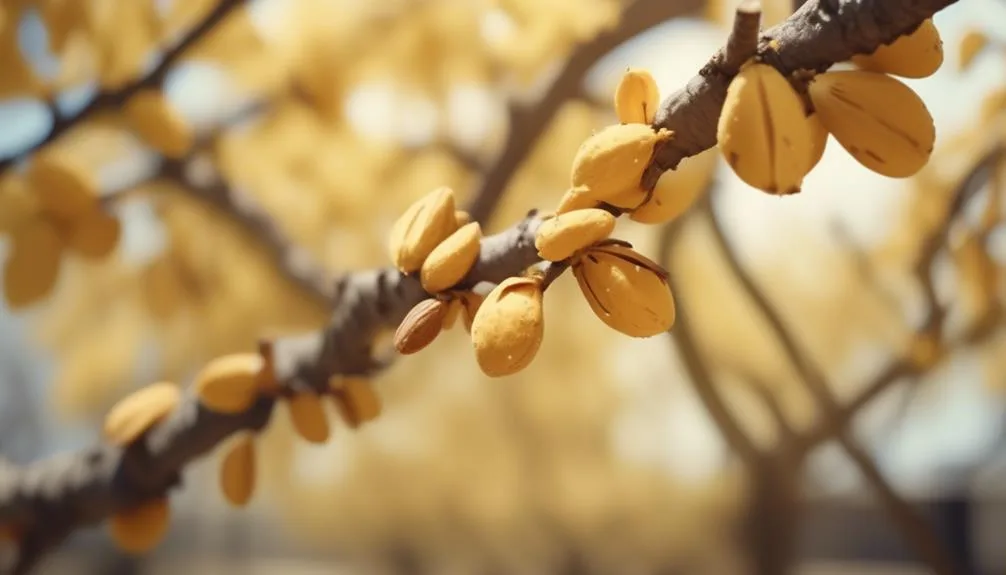Are you curious about almond trees losing their leaves?
As the seasons change, you might notice leaves falling from your almond tree. It's natural to wonder if this is normal.
Understanding why almond trees shed their leaves can help you take better care of your tree. Let's explore the reasons behind leaf drop in almond trees to gain valuable insights into this natural process.
Key Takeaways
- Nutrient deficiencies, pests, diseases, and adverse environmental conditions can all contribute to leaf drop in almond trees.
- Nutrient deficiencies, particularly nitrogen, potassium, and magnesium, can weaken the tree and make it more susceptible to leaf drop.
- Pests like aphids and mites, as well as diseases like powdery mildew, can weaken almond trees and lead to leaf drop.
- Adverse environmental conditions such as drought, extreme temperatures, and waterlogged soil can cause the tree to shed leaves.
Leaf Drop in Almond Trees
If your almond trees are experiencing leaf drop, it could be due to a variety of factors such as nutrient deficiencies, pest infestations, or environmental stress. Nutrient deficiencies, particularly nitrogen and potassium, can cause almond trees to shed their leaves prematurely. This often results in yellowing or browning of the leaves before they drop.
Additionally, environmental stressors like extreme temperatures, drought, or waterlogged soil can also lead to leaf drop in almond trees. High temperatures and lack of water can cause the tree to shed leaves to conserve energy and water. On the other hand, waterlogged soil can lead to root rot, inhibiting the tree's ability to take up nutrients and causing leaves to drop.
Understanding these factors can help you identify and address the underlying issue causing leaf drop in your almond trees.
Causes of Leaf Drop
When almond trees experience leaf drop, it can be attributed to a range of factors such as nutrient deficiencies, pest infestations, and environmental stress.
These causes of leaf drop include:
- Nutrient Deficiency: Almond trees may experience leaf drop due to a lack of essential nutrients like nitrogen, potassium, or magnesium, which are crucial for healthy leaf development.
- Pests and Diseases: Infestations by pests such as aphids, mites, or diseases like powdery mildew can weaken the tree, causing leaves to drop prematurely.
- Environmental Stress: Adverse environmental conditions such as drought, extreme temperatures, or inadequate sunlight can lead to leaf drop as the tree struggles to cope with these stressors.
Understanding these potential causes can help you identify and address the underlying issues to prevent further leaf drop in your almond trees.
Normal Leaf Drop
During the autumn season, almond trees naturally shed a certain number of leaves as part of their normal growth cycle. This process, known as normal leaf drop, is a response to the seasonal changes that occur.
As the days become shorter and temperatures begin to cool, almond trees prepare for the winter months by shedding older leaves. This shedding allows the tree to conserve energy and allocate resources more efficiently.
Normal leaf drop is essential for the overall health and vitality of the tree, enabling it to enter a period of dormancy during the colder months. While it may seem concerning to witness leaves falling, especially if it's your first time experiencing this natural occurrence, rest assured that it's a normal and necessary part of the almond tree's life cycle.
Abnormal Leaf Drop
Coming off the heels of the natural shedding process, abnormal leaf drop in almond trees can indicate underlying issues that require attention and intervention.
If you notice abnormal leaf discoloration such as yellowing, browning, or blotching, it may be a sign of nutrient deficiencies. This can occur when the tree lacks essential nutrients like nitrogen, potassium, or magnesium.
Additionally, sudden and excessive leaf drop, especially outside the normal seasonal shedding, can be a red flag for potential problems such as root rot, pest infestations, or diseases.
Keep a close eye on the overall health of your almond trees and consider conducting soil tests to assess nutrient levels. Prompt action and proper care can help address these issues and prevent further damage to your almond trees.
Managing Leaf Drop
To effectively manage leaf drop in almond trees, there are several steps you can take. First, assess the overall health of the trees and address any underlying issues that may be contributing to abnormal leaf shedding.
Ensure that the trees are receiving adequate nutrients, especially nitrogen, potassium, and magnesium, as deficiencies in these can lead to premature leaf drop. Regular soil testing can help determine if any nutrient deficiencies are present and allow for appropriate fertilization.
Additionally, consider seasonal changes and the impact they may have on leaf drop. Provide proper irrigation during dry periods and adjust watering schedules as the seasons transition.
Pruning can also help manage leaf drop by improving air circulation and sunlight exposure. By managing nutrients and considering seasonal variations, you can help mitigate excessive leaf drop in your almond trees.
Conclusion
In conclusion, while almond trees naturally shed some leaves, excessive leaf drop or other concerning symptoms should be investigated and addressed.
By providing proper care and monitoring, you can ensure the health and vitality of your almond trees.
Remember to stay attentive to their needs and take proactive steps to maintain their well-being.

